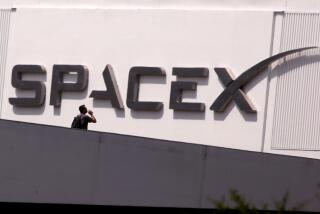Full Speed Ahead : TRW’s Gear-Shifting Makes Space Unit a Key Asset Again
- Share via
Only three years ago, TRW Inc. was under pressure to jettison its space and defense operation based in Redondo Beach. The group’s sales and profits were dwindling in the post-Cold War era and holding back the overall growth of TRW, which also makes air bags and other automotive parts.
But TRW’s square-jawed chairman, Joseph T. Gorman, rejected the idea outright, even though many other aerospace firms were rapidly consolidating.
“We vowed that we were not only going to halt the decline in sales but begin to grow the [space] operation, and we developed tactics to do just that,” Gorman said in a telephone interview from TRW’s Cleveland headquarters.
Those tactics are paying off.
Last week, the group reported an 11% gain in 1996 operating profit to $247.1 million, the highest level in six years. The group also posted a 9% gain in sales to a record $3.36 billion--its third consecutive year of higher sales.
That helped TRW’s total sales rise 3% to $9.9 billion last year, while its earnings increased 6% to $472 million.
TRW’s space group primarily makes military and commercial satellites, aircraft avionics, complex systems for warfare communications and high-energy lasers for aerial combat. It also has a variety of commercial projects that involve cutting-edge electronics, systems integration and imaging and communications gear, such as automated fingerprint-identification systems.
Gorman’s strategy to rebuild the space and defense business included not only pursuing as many remaining Pentagon contracts as possible, but capturing new business from outside the Defense Department. So TRW is now performing work for the Treasury Department, the Federal Aviation Administration, British law enforcement, Jamaican elections officials and Taiwanese and South Korean communications agencies.
That diversity will propel TRW’s future growth as well, Gorman said, as will the advent of commercial satellite networks that are promising telecommunications for every corner of the planet. TRW, in fact, is leading one such project, called Odyssey, that will use a dozen TRW-built orbiters.
To be sure, the space and defense group’s recovery has been a painful process. To help the division survive the deep cuts in Pentagon spending, TRW slashed the group’s work force from 30,000 in the late 1980s to less than 17,000 in 1994--making it a key player in shrinking Southern California’s once-vaunted aerospace industry.
But TRW’s space employment is swelling again. The group, which also has a major facility in Carson, has added more than 1,500 people in the last two years, lifting its total work force to 18,770.
The rebound is all the more impressive because it’s occurred without the help of acquisitions. Unlike rivals such as Lockheed Martin Corp., TRW has largely stayed out of the aerospace industry’s merger spree.
Indeed, TRW’s biggest transaction was to divest its consumer credit-reporting business--now called Experian Corp.--in 1996. That left TRW as primarily a maker of air bags and other automotive products, in addition to space and defense gear.
The space group gained $4 billion of new orders last year, following a gain of $3.8 billion in 1995. Among its key victories: TRW was part of a Boeing Co.-led team that won a $1.1-billion contract from the Air Force to build a laser-armed warplane that could shoot down enemy missiles at long range.
To survive, though, TRW knew it had to garner more commercial work. So, the company has been building satellites that measure the Earth’s ozone layer, on behalf of the National Aeronautics and Space Administration. TRW also is working on a satellite communications system for Taiwan using a satellite called ROCSAT.
The company also is building the dozen satellites that will be used by the $3-billion Odyssey global communications network being developed by TRW and Teleglobe Inc. of Canada. And TRW has been boosting its output of exotic computer chips made of gallium arsenide, which are faster than the traditional silicon-based chips.
In the late 1980s, only about 5% of TRW’s sales came from outside the Department of Defense; today that figure is between 30% and 40%, Gorman said. “But we don’t want to move away from the DOD, we want to expand beyond the DOD while retaining all of our traditional business” with the Pentagon, he said.
Having refused to sell its aerospace operation, would TRW entertain buying someone else’s?
“It’s still on our radar screen,” especially if a deal “would add some critical mass” to TRW’s existing strengths, said Gorman, a Yale Law School graduate who became TRW’s chief executive in 1988.
“But we don’t feel compelled to do it,” he said. “Bear in mind that when you talk about critical mass, we have about 9,500 engineers and scientists, and that’s more than most companies have that are many times our size. So I feel pretty good about our strategic position.”
Times staff writer James F. Peltz can be reached at [email protected]
(BEGIN TEXT OF INFOBOX / INFOGRAPHIC)
Lifting Off Again
After slumping in the early 1990s, TRW Inc.’s space and defense group is thriving again with the help of more commercial contracts. A look at the group’s financial picture:
Sales (in billions):
1990: $3.33
1991: $3.13
1992: $2.94
1993: $2.79
1994: $2.81
1995: $3.10
1996: $3.36
Source: TRW Inc.
*
Operating profit (in millions):
1990: $254
1991: $226
1992: $213
1993: $199
1994: $175
1995*: $222
1996*: $247
* Excludes one-time gains and charges.
Major Products:
Military, commercial communications and Earth-observation satellites
Battlefield command, control and communications electronics
Aircraft avionics
Unmanned aerial vehicles
High-energy laser technology
Semiconductors
Source: TRW Inc.
More to Read
Inside the business of entertainment
The Wide Shot brings you news, analysis and insights on everything from streaming wars to production — and what it all means for the future.
You may occasionally receive promotional content from the Los Angeles Times.











